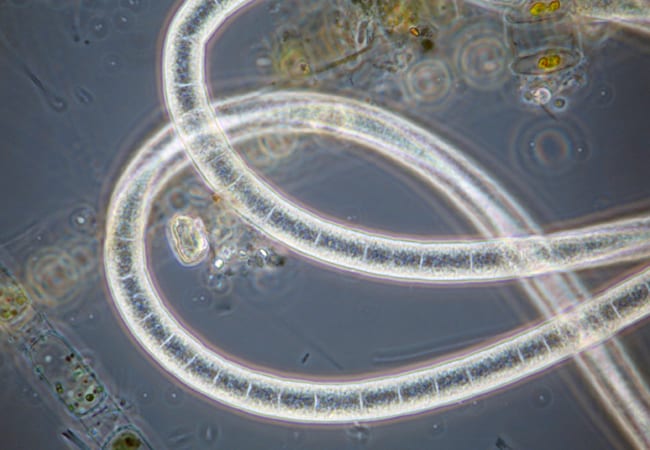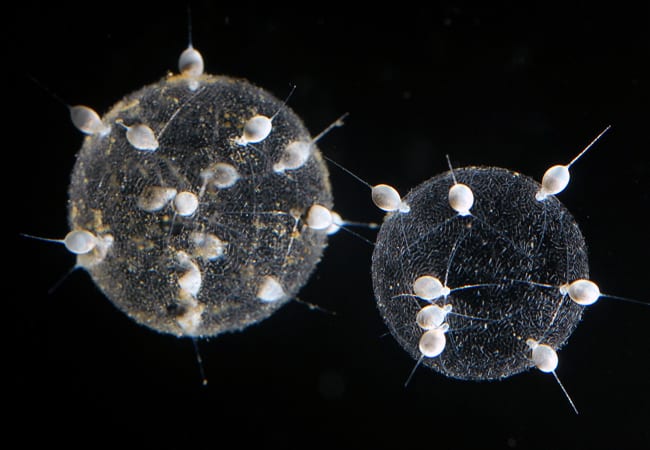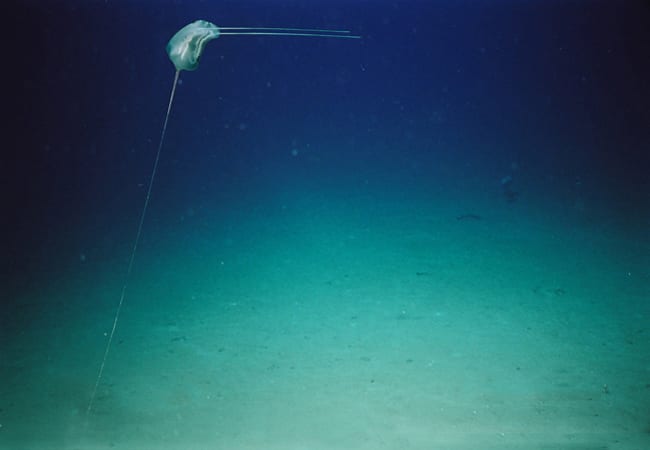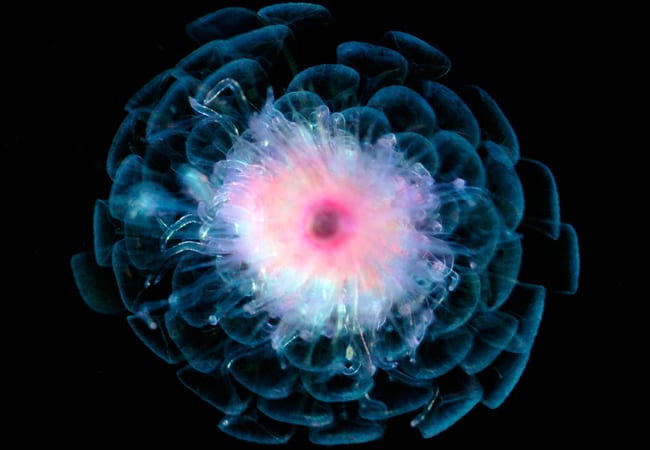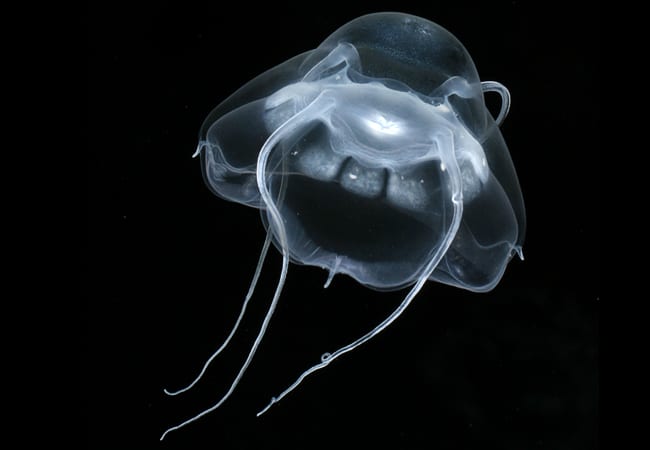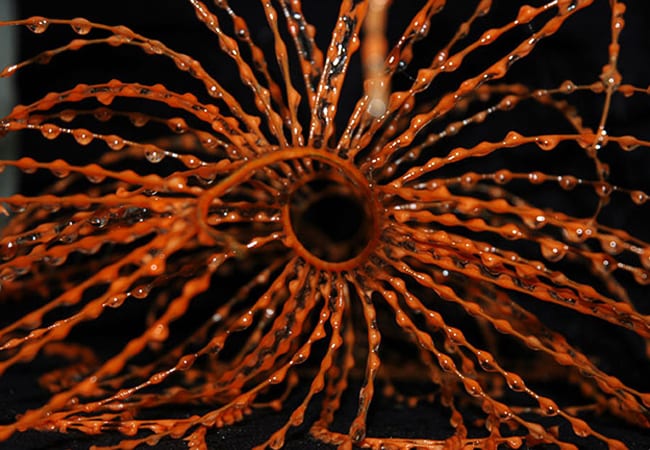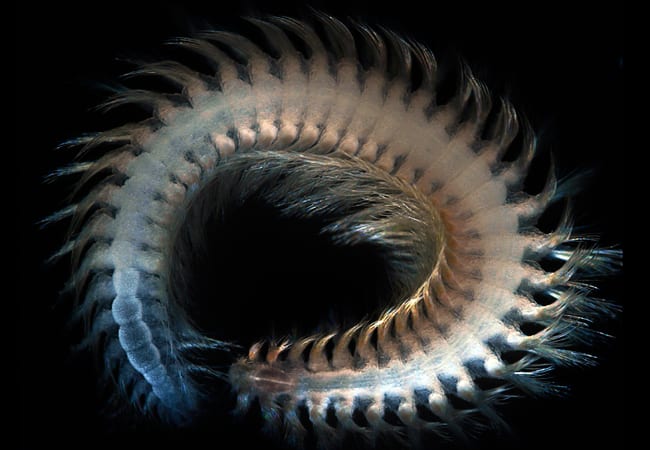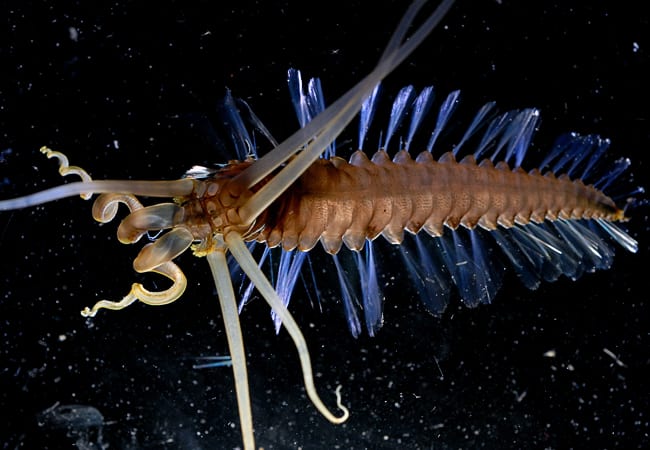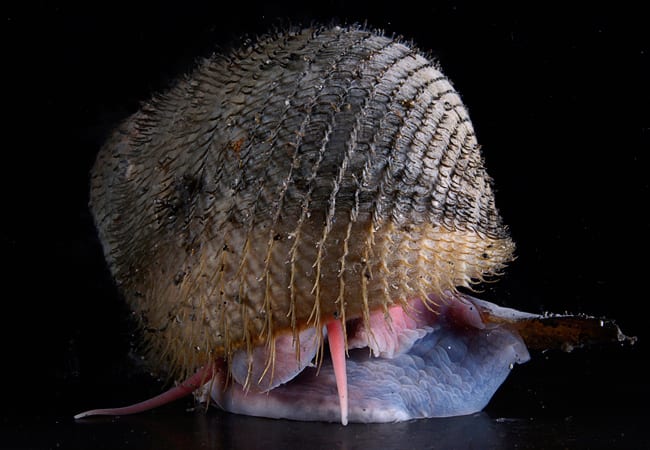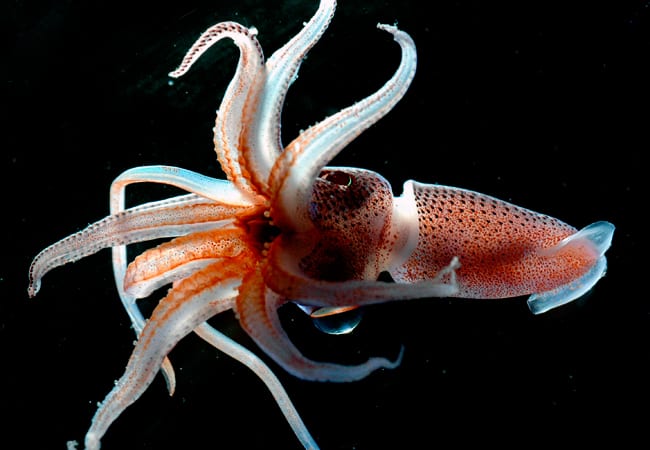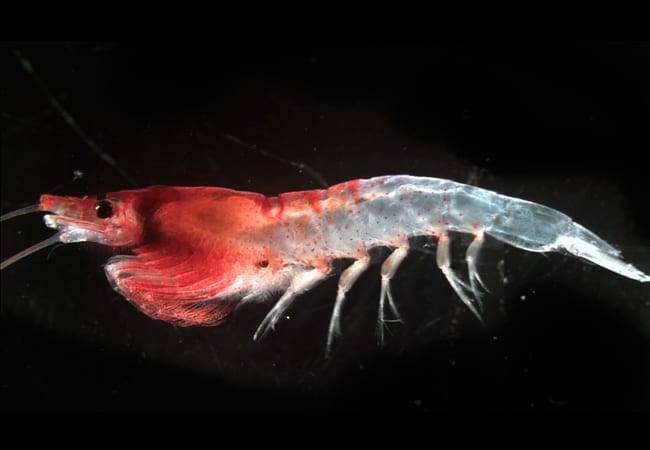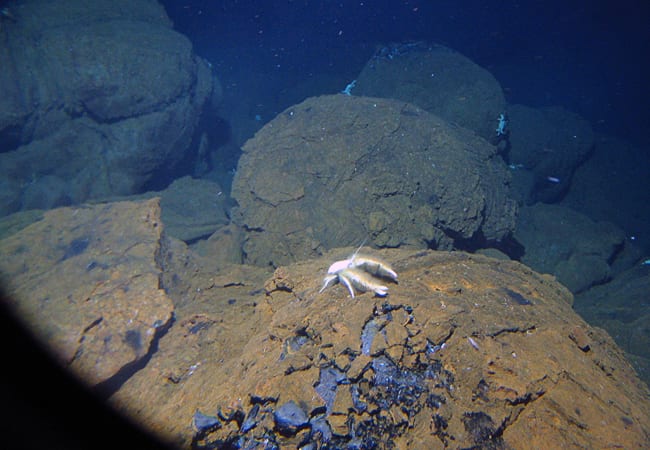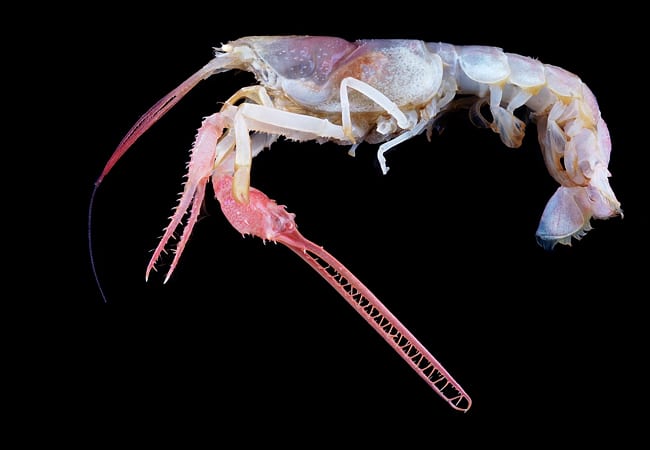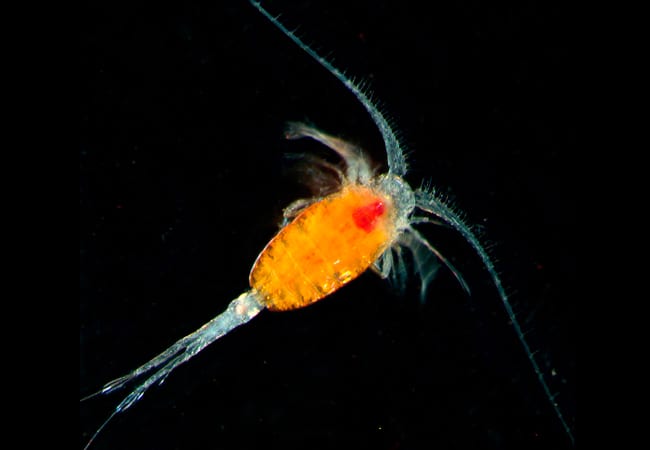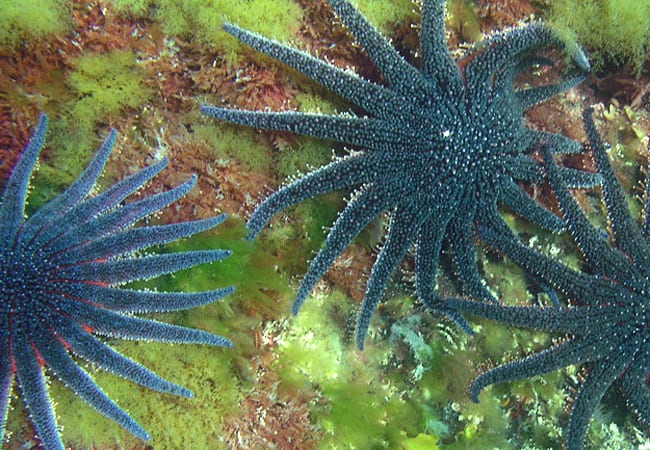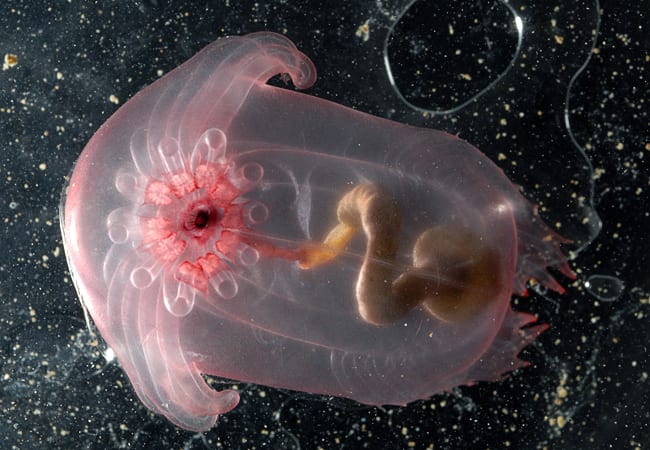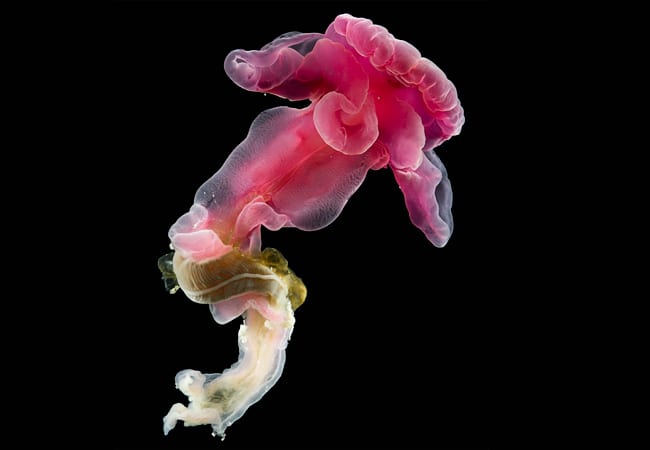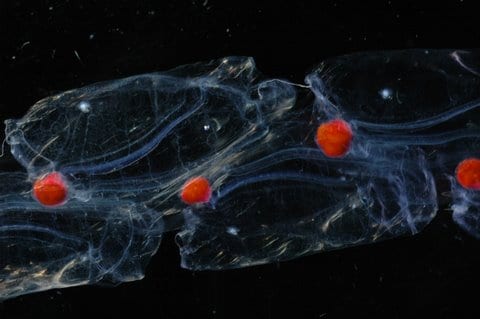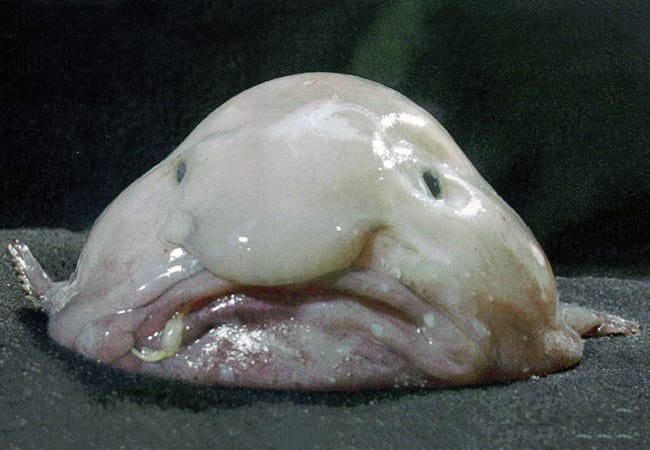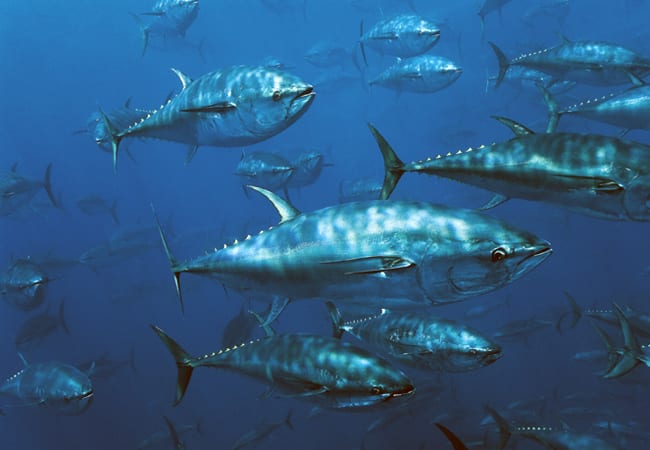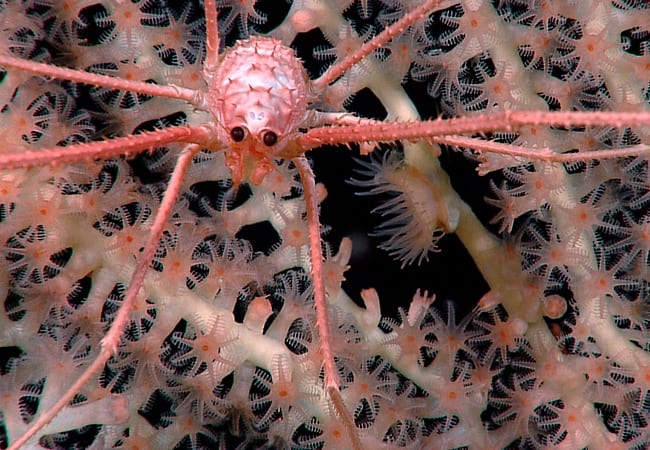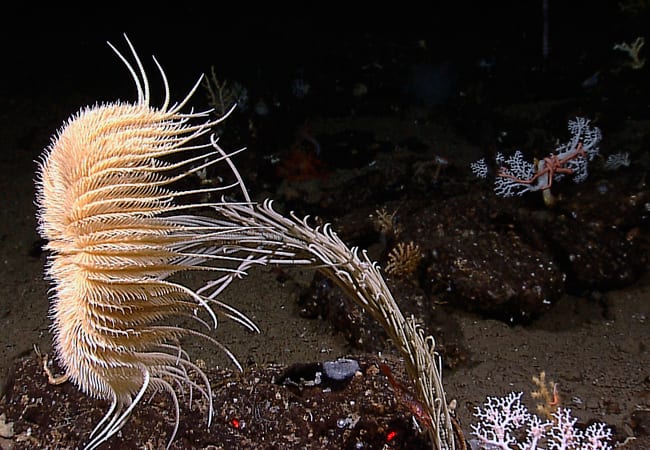What’s Living in the Ocean?
- Researchers found giant filamentous (strand-forming) bacteria living in oxygen-deficient, high-sulfur sediments of the eastern South Pacific. This new species may use chemicals as an energy source. (Photo by Carola Espinoza, Universidad de Concepción, Chile.)
- Tiny drifting crystalline globes are colonial forms of single celled organisms called radiolarians, collected deep in the Celebes Sea off the coast of the Philippines. White individual cells dot the outer surface of the colonies' geodesic dome-like structures made of glassy slivers of silica. (Photo by Larry Madin, Woods Hole Oceanographic Institution.)
- First seen in 2002, a foot-long 'comb-jelly,' or ctenophore, clings to the floor of the ocean's abyss by one stretched tentacle. Comb-jellies are fragile gelatinous animals found in all oceans. Photographed by a remotely operated vehicle at a depth of 7,217 meters (4.48 miles) in the Ryuku Trench off Japan, this new species holds the record as the deepest living ctenophore. (Photo courtesy of JAMSTEC-CMarZ.)
- What appears to be a delicate pink flower is instead a carnivorous animal that catches prey with stinging cells. A relative of jellyfishes, Athorybia rosacea is only an inch wide. It was collected near the sea surface by SCUBA divers on a Census of Marine Zooplankton cruise in the Sargasso Sea. (Photo by Larry Madin, Woods Hole Oceanographic Institution.)
- Researchers surveying marine life of the Arctic Ocean were surprised to find a completely unknown but abundant species of jellyfish, at depths below 1000 meters (3,280 ft). Hundreds of the new species Bathykorus bouilloni were observed with a remotely operated vehicle. (Photo copyright of Kevin Raskoff, Monterey Peninsula College.)
- In 2007, scientists using a remotely operated vehicle to explore the deep Gulf of Mexico sea floor below 1,000m (3,280 ft) observed this spiral sea-whip coral, located in an area named Coral Garden. This single coral harbored several other kinds of organisms living in association with it. (Image courtesy of Aquapix and Expedition to the Deep Slope 2007.)
- This worm, a new species, was collected on a whale fall, 925 meters (3,035 feet) deep in Sagami Bay, Japan. A “whale fall” is a whale carcass that has sunk to the ocean floor, serving as a source food for deep-sea species, including some of the same animals found at chemical seeps. (Photo by Yoshihiro Fujiwara/JAMSTEC.)
- In 2007, U. S. and Filipino scientists searching the deep water of the Celebes Sea for new species discovered this unusual 4-inch worm swimming 2,800 m (1.7 miles) down. They nicknamed the new species “Squidworm” before it was given its scientific name: Teuthidodrilus samae. (Photo by Larry Madin, Woods Hole Oceanographic Institution.)
- A snail whose shell is completely covered in rows of hair-like projectons was collected at a deep hydrothermal vent at Suiyo Seamount off Japan. The specimen is probably a new species, and is the only one of its species found thus far. Like many animals living at vents, the snail harbors chemosynthetic bacteria in its tissue. (Photo by Yoshihiro Fujiwara/JAMSTEC.)
- Scientists collected this six-inch squid at depths near 1,000m (3,000 ft) in the Sargasso Sea during a landmark Census of Marine Zooplankton expedition to identify and analyze genetic material of planktonic animals in the Atlantic Ocean. Its two eyes are of different sizes, and it is covered with pigment-bearing spots that enable it to change its color and appearance. (Photo by Larry Madin, Woods Hole Oceanographic Institution.)
- A red shrimp-like animal, one of several species called krill, was collected on a Census of Marine Zooplankton expedition to the Sargasso Sea to survey, identify, and genetically “barcode,” or type, animal plankton. Krill are critical links in ocean food webs, eaten by animals from fish to whales. (Photo by Nancy Copley, Woods Hole Oceanographic Institution.)
- In the inhospitable, chemical-laden environment of a hydrothermal vent in the deep southeast Pacific near Easter Island, Census of Marine Life explorers discovered a new species of crab covered with long white fur. Soon nicknamed the Yeti crab, the six-inch Kiwa hirsuta belongs to a new family, genus, and species. (Cindy Van Dover, Duke University Marine Laboratory.)
- A new species, a blind lobster with long, oddly-shaped claws, was collected on the seafloor at about 300m (984 feet) during the MNHN/USNM/BFAR AURORA 2007 expedition off the Philippines. Its scientific name is Dinochelus ausubeli - derived from the Greek dinos, meaning terrible, chela, meaning claw, and ausubeli, honoring Jesse Ausubel, a co-founder of the Census of Marine Life. (Photo by Tin-Yam Chan, National Taiwan Ocean University, Keelung.)
- Copepods are tiny swimming animals that reach great abundance seasonally in the ocean and are a main source of food for many fishes and marine mammals, including whales. Census researchers in the Arctic Ocean found this bright orange copepod, Lucicutia aurita, below 1000m (3,280 feet) depth. (Photo by Russ Hopcroft, UAF/NOAA/CoML.)
- Called “sunflower stars,” three bright blue sea stars Pycnopodia helianthoides crawl over the green seafloor in shallow waters off Knight Island in Prince William Sound, Alaska, USA. These large, fast-moving sea stars can grow to a meter across and can have as many as 24 arms. (Photo by Casey Debenham, University of Alaska Fairbanks.)
- A team of U.S. and Filipino scientists captured this transparent swimming sea cucumber over 1.5 miles down in the Celebes Sea. After eating bottom mud, it swims up into the water by undulating the frilly collar around the top of its body. (Photo by Larry Madin, Woods Hole Oceanographic Institution.)
- Scientists surveying deep-sea life on the Mid-Atlantic Ridge and using a remotely operated vehicle to explore depths between 700 meters (2,296 feet) and 3,600 meters (2.24 miles) collected several new deep-sea species of a little-known animal called “acorn worms” (or enteropneusts). Acorn worms lack a brain, eyes, or organs, but have a head and tail end, and worms may be transitional between invertebrates and backboned animals. The scientists discovered three distinct species, colored pink, purple, and white, and saw the animals feeding, moving, and leaving characteristic spiral traces on the sea floor. (Photo courtesy of David Shale.)
- Snaking through the upper levels of the ocean, a long chain-shaped colony of linked one-inch-long animals called salps swims by jet propulsion—each animal takes in water at the front and forces it out the back, causing forward motion. This chain of Salpa aspera was captured by SCUBA divers, then identified and genetically typed by researchers on a Census of Marine Zooplankton cruise in the north Atlantic. (Photo by Larry Madin, Woods Hole Oceanographic Institution.)
- Exploring deep seamounts and ridges, a June, 2003 expedition north-west of New Zealand captured this fish, called a “fathead” Psychrolutes microporos, between 1013 meters (3,323 feet) and 1340 meters (more than 2 miles) deep on the Norfolk Ridge. (Photo copyright NORFANZ Founding Parties, Photo by Kerryn Parkingson, additional thanks to Peter McMillan and Andrew Stewart.)
- Census of Marine Life researchers surveyed and tracked large predatory fish that are declining in population, such as these Bluefin Tuna Thunnus thynnus. (Photo courtesy of Richard Hermann-Galatée Films.)
- During the ten-year Census of Marine Life, other agencies and partnerships also carried out explorations of Earth's oceans and helped document the seas' biodiversity. For example, a 2010 joint U.S.-Indonesian expedition, supported by the National Oceanic and Atmospheric administration Office of Ocean Exploration and Research, surveyed and made video records of species in a part of Southeast Asian waters known as the “Coral Triangle” that is considered the most diverse ecosystem in the world. Seen at 704 meters (2,310 feet) depth on a newly-mapped seamount, this crab with 8-inch arms is a species only observed living on soft coral. (Image courtesy of NOAA Okeanos Explorer Program, INDEX-SATAL 2010.)
- In the waters of the “Coral Triangle,” region of Southeast Asia, researchers on a joint U.S.-Indonesia expedition to survey marine life in this richly diverse area observed this sea lily (a crinoid, related to sea stars) at 1,876 meters (1.17 miles) deep on the Kawio Barat submarine volcano. With its arms pointed in the direction of the current, a sea lily captures food particles drifting by. The image was captured by the Little Hercules remotely operated vehicle. (Image courtesy of NOAA Okeanos Explorer program, INDEX-SATAL 2010.)
Image and Visual Licensing
WHOI copyright digital assets (stills and video) contained on this website can be licensed for non-commercial use upon request and approval. Please contact WHOI Digital Assets at images@whoi.edu or (508) 289-2647.

